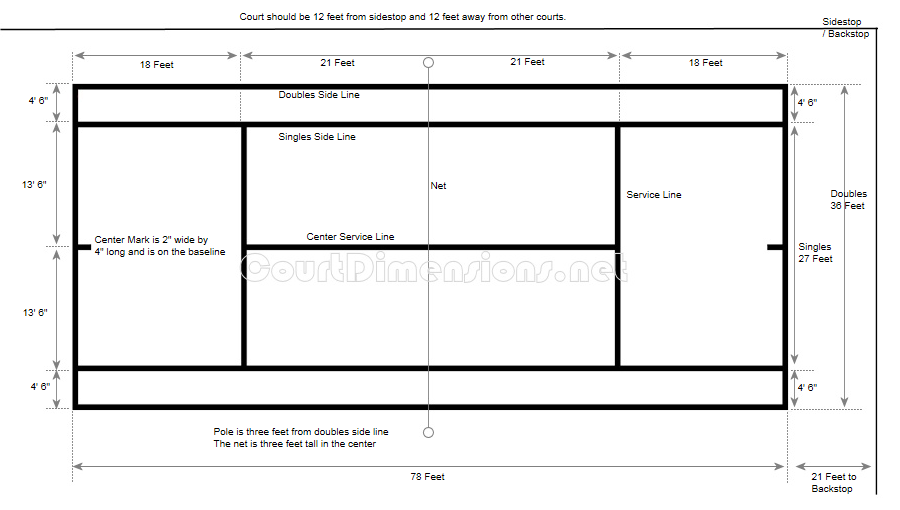Tennis Court Dimensions
Tennis Court Dimensions & Measurements
Tennis Court Diagram
Quick Facts About Tennis Court Measurements
What is the length and width of a tennis court?
The width of a tennis court is 78 feet, or 39 feet on each side of the net. The width is 36 feet for doubles and 27 feet for singles.
How tall should the net be?
It should be on the ground and three feet tall at the center.
How far should tennis courts be apart from each other?
A minimum of 12 feet.
How much space should their be between the court and the fence (backstop)?
21 feet is the minimum recommendation.
How far is the pole from the sideline?
Three feet.
How wide should the lines be?
Two inches.
A Brief History of Tennis
Tennis, with its graceful rallies and strategic exchanges, is a sport that transcends age, social barriers, and even physical limitations. From enthusiastic youngsters wielding mini-racquets to wheelchair athletes showcasing remarkable athleticism, tennis offers a pathway for anyone to experience the thrill of the game. But this seemingly modern sport boasts a surprisingly long and fascinating history, evolving from a royal pastime to a global phenomenon.
The earliest roots of tennis can be traced back to 12th century France. Imagine a game where players used their bare hands, not sophisticated racquets, to strike a ball back and forth across a court. This early ancestor of tennis, known as “jeu de paume” (game of the palm), was a favorite pastime of French aristocracy. It wasn’t until the 16th century that wooden paddles began to replace hands, and the game itself acquired the name “tennis.” The word’s origin stems from the Old French term “tenez,” which translates to “hold,” “receive,” or “take,” reflecting the act of receiving and returning the ball. Interestingly, tennis was primarily played indoors during this era, and the invention of the lawn mower in 1830 gets an unexpected credit – it paved the way for the eventual shift of the sport outdoors.
Fast forward to mid-19th century England. A gentleman named Harry Gem, along with his friend Augurio Perera, embarked on a creative endeavor. They combined elements of racquets and a Basque ball game called pelota, creating a new game they played on Perera’s croquet lawn in Birmingham. This innovative spirit, coupled with the support of two local doctors, led to the founding of the world’s first tennis club in Leamington Spa in 1872.
While Gem and Perera were instrumental in the sport’s evolution, another figure, Walter Clopton Wingfield, often receives credit for shaping modern tennis. In 1873, Wingfield patented a similar game called “sphairistikè,” complete with a boxed set that included a net, poles, racquets, and balls – a portable tennis kit for anyone to enjoy. This innovation proved particularly influential across the Atlantic. U.S. socialite Mary Ewing Outerbridge, captivated by the potential of Wingfield’s set, brought it back to America, eventually playing a pivotal role in establishing the first American National Championship on Staten Island in 1880.
Today, the pinnacle of achievement in professional tennis lies in conquering the four prestigious Grand Slams – the Australian Open, the French Open, Wimbledon, and the US Open. These tournaments, along with the Olympic Games, the Davis Cup (men’s international team competition), the Billie Jean King Cup (women’s international team competition), and the Hopman Cup (mixed-doubles team event), are all governed by the International Tennis Federation (ITF). Grand Slams hold a special place in the tennis world, offering the highest prize money, double ranking points for champions, and larger singles player fields compared to other tournaments. They are also the only tournaments to feature mixed-doubles competition.
Tennis’s global appeal is undeniable. Played in virtually every corner of the world, it transcends cultural and geographical boundaries. This remarkable accessibility and universality solidify tennis’s position among the top five most popular sports on the planet. From its royal court origins to its electrifying professional circuit, tennis offers a rich tapestry of history, athleticism, and pure joy of competition, making it a sport that continues to enthrall audiences and inspire players of all ages and abilities.

